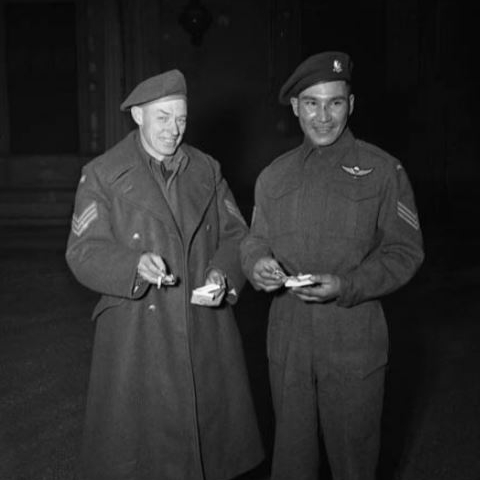Thomas George “Tommy” Prince National Historic Person (1915–1977)

© Christopher J. Woods / Canada Department of National Defence / Library and Archives Canada / PA-142289
Thomas George "Tommy" Prince was designated as a national historic person in 2019.
Historical importance: Indigenous veteran of the Second World War and the Korean War, he represented the interests of First Nations in Manitoba at the national level.
Commemorative plaque: No plaque installed Footnote 1
Thomas George "Tommy" Prince (1915–1977)
Tommy Prince was a prominent Anishinaabe activist and veteran whose brave and tragic life has long held popular resonance. His story is one of the most widely known examples of the wartime contributions of First Nations soldiers in the mid-20th century, and the poor treatment they received upon their return to civilian life in Canada. His accomplishments attracted national media attention during his lifetime and earned him a great many posthumous tributes.
Thomas George Prince was a founding member of the elite 1st Canadian Parachute Battalion and First Special Service Force (Devil’s Brigade) during the Second World War. In 1951, he contributed to the stalwart defence of Hill 677 in the Battle of Kap’yong during the Korean War, for which the United States awarded the Princess Patricia’s Canadian Light Infantry the Distinguished Unit Citation—the only time a Canadian unit has received this honour. In addition, he was a prominent leader in the First Nations rights movement of the 1940s. He represented the interests of First Nations in Manitoba at the national level, advocating for the abolition of the Indian Act and urging respect for existing treaties during his high-profile testimony before a landmark Special Joint Committee of the Senate and the House of Commons in 1947. The participation of Prince and other First Nations leaders represented important federal recognition of their political leadership that strengthened the movement for First Nations rights.
Prince was born in October 1915 in Petersfield, Manitoba. He was the great-great-grandson of the respected Ojibwa Chief Peguis, and one of eleven children born to Elizabeth and Henry (Harry) Prince. In 1920, they moved their family to Scanterbury, Manitoba, where they lived on the Brokenhead Reserve (Brokenhead Ojibway Nation). At age five, Tommy Prince was forced to leave his community to attend Elkhorn Residential School, where he joined the cadet corps.
In 1940, he volunteered to fight for Canada in the Second World War. He rose from sapper to lance corporal with the Royal Canadian Engineers before volunteering for the 1st Canadian Parachute Battalion in 1942. Soon after, he was assigned to the elite 1st Canadian Special Service Battalion, which was attached to the First Special Service Force (Devil’s Brigade). He reached the rank of sergeant by war’s end, and was one of three Canadians to receive both the Silver Star (U.S.) and the Military Medal. King George VI presented him with both honours during a ceremony at Buckingham Palace in 1945, shortly before Prince’s discharge from the army.

© Christopher J. Woods / Canada Department of National Defence / Library and Archives Canada / PA-142287
.jpg)
© Lieutenant Christopher J. Woods / Canada Department of National Defence / Library and Archives Canada / PA-142288
After the war, he agreed to serve as spokesperson and vice-president of the Manitoba Indian Association, and appeared on its behalf before a Special Joint Committee of the Senate and House of Commons, tasked with studying the Indian Act. During his testimony in 1947, he advocated for the abolition of the Indian Act and respect for existing treaties, and presented submissions from First Nations in Manitoba, which called for improved schools, better living conditions, and expanded hunting, trapping, and fishing rights.
In 1950, Prince re-enlisted when Canada entered the Korean War. He served with the Second Battalion, Princess Patricia’s Canadian Light Infantry and participated in the stalwart defence of Hill 677 in the Battle of Kap’yong (1951).
Military service took a heavy toll on his health and, following his honourable discharge from the army, he faced a difficult return to civilian life in Manitoba. Tommy Prince endured discrimination, illness, and poverty in the years that followed, and died in 1977.
Backgrounder last update: 2019-07-29
The National Program of Historical Commemoration relies on the participation of Canadians in the identification of places, events and persons of national historic significance. Any member of the public can nominate a topic for consideration by the Historic Sites and Monuments Board of Canada.
- Date modified :